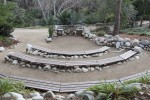Of the dozen libraries located on the UCLA campus, students are probably most familiar with the Powell Library or the Charles E. Young Research Library. However, Wayne Dollase, a professor emeritus in the department of earth and space sciences, recognizes a thirteenth library on campus: the Mildred E. Mathias Botanical Garden.
Dollase describes the garden as a botanical reference library filled with about 5,000 species of plants, 1,300 of which have received new labels in the last six years.
Courses from all disciplines should work to incorporate this valuable resource into their curriculum. Dollase has created an online catalogue of the genus, species, family and common name of about 500 species scattered around campus.
For UCLA students, staff and faculty, the garden and Dollase’s website can provide a break from the hustle and bustle of the city.
Thomas Gillespie, a professor of geography, often brings his Geography 5: People and Earth’s Ecosystems classes to the botanical gardens for hands-on lessons.
“It’s much easier to explain a concept like seed dispersal,” Gillespie said. “When you go outside you can actually see the seeds spiraling down like helicopters.”
Looking at pictures on a slideshow is not nearly as effective as taking students outside and actually showing them the plants.
For his upper division course, Forest Ecosystems, Gillespie said he holds class outside almost every other day. The botanical garden is a particularly great resource for studying tropical forests because it contains the highest diversity of Hawaiian plants outside of the state itself, he said.
Gillespie’s Geography 5 class uses an outdoor classroom known as “the nest,” which is located near the north entrance to the Mildred Botanical Gardens. Consisting of a semicircle of seats and a compartment with whiteboards, the Wi-Fi-free amphitheater can be used by any seminar and provides a place where students can directly engage with the environment, free from distractions.
Outside, English students can better understand why Romantic poets like Wordsworth wrote about man’s relationship to nature. Mathematics students can study the fractals on ferns. The possibilities of this interdisciplinary resource abound.
But students and professors don’t even have to make the trek to the Botany building to find rare and plentiful nature. They simply need to step outside their lecture hall.
Although the seven-acre botanical gardens contain an enormous variety of flora and fauna, few people recognize that the 400-acre campus itself is host to great biodiversity.
Locations like Sage Hill, a hilly area behind the residence halls, and Stone Canyon Creek, situated near the UCLA Anderson School of Management, are both examples of UCLA’s contained biomes.
Outside Boelter Hall, a dainty white flower resembling a shellfish pops out from behind reddish leaves. The plant, Justicia brandegeana, is aptly known as the “shrimp plant.”
Students grabbing a snack from the vending machines next to Schoenberg may hardly notice the Carab tree shading them, but it’s a great example of the stories the plants could tell us.
The tree is actually responsible for the origin of the phrase “24-carat gold” because Romans measured the weight of pure gold against the weight of carat seeds from the Carab tree.
This natural wealth is catalogued on Dollase’s website along with hundreds of others found around campus.
While the botanical gardens have volunteers that provide tours to various groups – community garden clubs or elementary school classes – tours do not include the plants found around the rest of campus. Carol Felixson, coordinator of the garden’s docent program, said students can volunteer to lead the tours, although the majority of garden docents are currently UCLA staff members or retired persons.
One way to better utilize our thirteenth library may be to expand the botanical garden’s tour program to the entire campus.
In a city infamous for smog and concrete, UCLA should take advantage of its rich natural resources. The benefits of holding class outdoors are numerous – from relieving student stress to saving energy in the classroom.
Professors should diversify learning by taking advantage of its botanical libraries – both the gardens and the campus as a whole.
Email Beck at mbeck@media.ucla.edu or tweet her @meganbeck14. Send general comments to opinion@media.ucla.edu or tweet us @DBOpinion.

Pretty nice looking place!